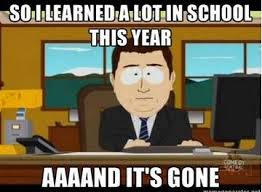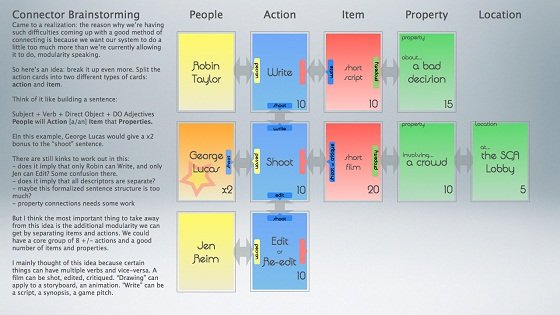
But actually, I learned SO much!
While my chosen meme may reflect how I feel about the rest of my classes, I feel confident in saying that Intro to Literacy Studies will be the class that ends up helping me the most in my goal of becoming a teacher. I learned (and intend on retaining) a great deal about how literacy, learning, and teaching all intertwine. And even though I got a lot out of this class, I’m now aware that there is still so much that I don’t know. There is always more to learn when it comes to literacy. Being cognisant of that fact alone is important in and of itself, I believe.
As I scoured all of the blog posts I wrote and the major course readings we read this semester, I realized that we really did learn about some big ideas in literacy. This is my chance to try to go about wrapping my head around it all! But first, allow me to critique my overall performance. I feel like I did pretty well in all areas of this course. I only missed one class this semester, which is something I’m proud of. I did the literacy narrative and attended WriteOn! I also completed all the blog posts and felt good about putting my work up on our class website. While I wasn’t the most active participant during class discussions, I was always attentive. I made sure I did my fair share in all the group work, from the book club movie trailer to the article group resource creation and presentation.
Starting with the Szed article, I was able to start constructing my paradigm of literacy. Szed asserted that people can be literate in different contexts, touched upon the difference between public and private literacy. To paraphrase myself from my first blog, “Szwed proposes that a boy who isn’t able to read assigned texts may actually be very good at reading and comprehending baseball cards and statistics (423). If a child isn’t being read to at home or /exposed to reading material outside of school, and the school thinks that he/she is, problems would arise. Even so, a child could still be literate at reading street signs through location identification instead of reading”.
In my second blog, I focused on “Interactions between people and written texts” from the Hamilton article. I learned about the participants, settings, artifacts and activities involved with literacy. Participants are people, groups or individuals. Settings can be anywhere where literacy is occurring. Here’s what I pulled from that blog: “Legal notices could indicate a courthouse while a scoreboard would apply to a sporting event”. The activity of literacy in these instances is not only reading, but can also involve discussion, displaying, and “disputing written texts of various sorts” (Hamilton, 28).
Completing the Literacy Narrative assignment gave me so much insight into how fast literacy has changed over the past half century. I also learned about sponsorship and how it relates to literacy. I interviewed my mom and got great feedback from her. Here’s my favorite quote from her: “As far as values my parents placed on reading and writing, I would say penmanship was important to Nana and that reading wasn’t really emphasized, rather it was just there. I do remember Nana bending over me and Uncle Bruce at the kitchen table teaching us how to properly hold our pencils and to sit up straight with our feet flat on the floor as we wrote. I also remember that Nana read to us often, and that Grandpa rarely did.” My grandmother placed an emphasis on good handwriting but not much on anything else. Reading was a skill just assumed to be acquired on one’s own in their household, but it was not taught or had any emphasis placed on its importance.
For my fourth blog, I discussed my experience with Twitter and how it related to Franklin’s experience. This was one of my favorite readings of the whole semester because it was so relevant to me and I really connected with it. To quote myself liberally is probably the best way to share what I learned. “I slowly came to grasp the inner workings of Twitter by intently reading the tweets of the people I followed, noticing which of my tweets received favorites and/or retweets (and tried to figured out how), and by not being scared of messing up. In a roundabout fashion, I’ve come to the point where I can confidently call myself proficient at using Twitter. To borrow from Franklin’s four keys to composing, I sought help from more Twitter-savvy journalists, studied my intended audience, and keyed in on Twitter’s terminology.” Twitter was once a new (and digital) literacy for me, but now have a solid grasp of the social media platform.
The ‘early synthesis’ blog unveiled quite a few things I had actually forgotten about, so I’m glad I reread it now. From Brandt’s idea of “literacy piling up over time”, Szed’s point that, in regards to literacy, “…the focus should be on the school and its relation to the community’s needs and wishes…” and as a future educator I believe that “…students need not only to be academically literate, but they should also be literate in their community’s function and inner workings. They need to be motivated to become extra-literate, and if they have real-world examples of what being literate in more than just school related literacies can do for them, they will appreciate their skills and yearn for more”. As for Williams’ Why Johnny Can Never, Ever Read, I was intrigued by the “Literacy as Cultural Capital” section. Williams’ asserts that middle class life is not about accumulating wealth, but by the ability to “convincingly adopt and perform a set of bourgeois behavior”. To reach and remain in the middle class, one must have the requisite literacy to survive there. I still wonder as to what extent this is true.
After reading a chapter of James Paul Gee’s What Video Games Have To Teach Us About Literacy and discussing it with my group, I was glad I picked the topic I did. Integrating principles of gaming into my future classroom is something I very much want to do. My chapter was about cultural models, which can be a bit tricky to label at first. “Cultural models are images, storylines, principles, or metaphors that capture what a particular group finds “normal” or “typical” in regard to a given phenomenon” (143). Gee uses games such as Sonic the Hedgehog, Under Ash, Operation Flashpoint: Cold War Crisis, and Metal Gear Solid to illustrate his many points regarding cultural models and how they shape how we view the world. Each of the games ties into a different example of what video games contribute to our literacy. One particular point Gee made that really impacted me was his telling of how the war video games he played totally changed his cultural model of warfare. You can’t always go full Rambo mode and charge full steam ahead; warfare is often slow, tedious, confusing and above all, ‘no one really knows what’s going on’.
For my article group work, I read about gaming culture knowledge and an alternative reality game being played by freshmen film students at USC. The first was a blog post on dmlcentral.net by Julian Sefton-Green titled Making Sense of Games, Gaming Culture Knowledge. One such observation he laid out was that the gamers’ “level of engagement and knowledge about gaming and other forms of popular digital culture…was ignored or marginalised by teachers and other adults in these young people’s lives”. Adults and educators were mostly oblivious to the unique and specialized knowledge these student-gamers possessed. “…the refrain was that for all the young persons’ expertise, it seemed significantly isolated from worldviews of their formal education. In other words, very few other adults who might have some influence on helping these people choose career paths really valued or knew anything about the kind of study or knowledge that these young people had put into these cultural forms. As a future educator, I “…need to recognise and explore both the nature of and the ways that these kinds of informal knowledge domains are built outside of the curriculum”, according to Sefton-Green. As for the ARG at USC, I found the whole premise innovative and creative. One student, after a semester of playing Reality, was glad for the opportunity to do something totally new. “I think the game was brilliant because it created an incredible space for experimentation and growth. It was brilliant because you felt safe because you can try things that were outside of your comfort zone, but you didn’t have to worry about a grade accompanied with it.” From the Reality operation (the making of an ARG and the students playing through it), I learned that collaboration is a huge part of the learning process, for the teams with more students accomplished much more than smaller groups. Ideas and resources were brought together for a common goal for a great impact on the game.
The presentations we had at the end of the semester sort of brought everything about literacy together for me. My favorite had to be the Make/Hack/Play group. My group made Robo-Claws with tape, cardstock, scissors, plastic straws, and string. I failed miserably on my first attempt but didn’t give up, and my second try was not perfect either, although it was better than my initial try. My takeaways from this presentation is that failure should be built into the curriculum for some lessons to teach students to be resilient, not give up when they fail, to work around issues, and communicate with each other.
So, what do I believe about literacy, learning and teaching at this point in my journey towards becoming an educator? I believe that every student is literate in different areas, some more or less so. It will be my job as their teacher to help them become school-literate and increase their reading, writing, and critical thinking skills. Learning is always an ongoing process and takes place through many forms. But I also think that every student wants to learn. Becoming more and more literate is how they will do so. As for teaching, well, I figure that if I can be as much like Kim as possible I’ll be just fine! Sure that will help, but being informed and skilled in all the new technologies and their applications to education certainly is something to be aware of for new teachers. Being passionate, showing equity and patience, demonstrating respect to gain it it back, and always giving my best effort each day are all what I feel comprises teaching. And having that innate desire to keep learning about literacy, learning and teaching is, probably above all, what matters the most to me.
Whew, what a class this has been. To everyone graduating-a big congrats! And as for myself, I have another year (and Kim’s 431 class!) to continue learning how to be the best teacher I can be. If you made it this far through my post, please accept an imaginary high five from me-thanks for reading! =D


 Website:
Website: